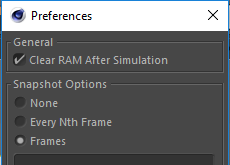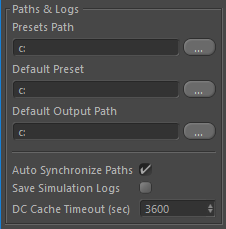Menu

The FumeFX menu options allow you to create FumeFX grid, sources, access preferences and to start or stop the simulation.
FumeFX Objects
 Create FumeFX grid.
Create FumeFX grid.
 Create Simple Source.
Create Simple Source.
 Create Object Source
Create Object Source
 Create Particle Source
Create Particle Source
 Create Void Source
Create Void Source
 Create Spline Follow
Create Spline Follow
 Create Effector
Create Effector
 Create Gravity
Create Gravity
 Create Wind
Create Wind
Simulation Control
 Start Simulation - Click on Preference button (gear icon) and then select Start Simulation from popup menu. Then click on Start button (play icon next to gear icon) to run a simulation from the Start Frame to the End Frame (parameters that are available inside the Output attribute group). Note that during the simulation, FumeFX will not block user interface. While FumeFX is running a simulation, you can change simulation parameters or even source and object parameters. However, you will not be able to render, change simulation type, change Extra Detail mode or change input cache.
Start Simulation - Click on Preference button (gear icon) and then select Start Simulation from popup menu. Then click on Start button (play icon next to gear icon) to run a simulation from the Start Frame to the End Frame (parameters that are available inside the Output attribute group). Note that during the simulation, FumeFX will not block user interface. While FumeFX is running a simulation, you can change simulation parameters or even source and object parameters. However, you will not be able to render, change simulation type, change Extra Detail mode or change input cache.
In Simulation Loop mode parameters such as Grid Dimension, Exporting Channels, Simulate Smoke/Fuel are updated when simulation starts over.
 Continue - You can use this option to continue a simulation from the point at which it had been stopped with the Stop button. FumeFX can continue from any frame that has already been calculated, provided that the velocity channel was exported. To select this option click on Preference button and then click on Continue Simulation -> Last Calculated Frame. Click on Start button to continue simulation.
Continue - You can use this option to continue a simulation from the point at which it had been stopped with the Stop button. FumeFX can continue from any frame that has already been calculated, provided that the velocity channel was exported. To select this option click on Preference button and then click on Continue Simulation -> Last Calculated Frame. Click on Start button to continue simulation.
Another option is to Continue from the current frame output; the position of the Cinema4D time slider indicates this continuing point. Click on Preference button and select Continue Simulation -> Current Frame Output. Then click on Start button to continue simulation.
You can also continue from any snapshots that you have specified. To select appropriate snapshot, click on Preference button and then on Continue Simulation. Under Select menu you can select which snapshot will be used to continue simulation. If snapshots were created with different grid parameters, you will be able to select Show same grid settings only, which will limit the selection range to matching files.
Stopping and continuing a simulation from a snapshot file will give you the exact same results as running a simulation uninterrupted. You can also continue from output files; however, since pressure is not saved in output files (.fxd), a slight difference will be introduced into the following frames. This difference will be evident in explosion effects.
In the events when simulation has reached the grid boundary and you needed it to expand even further, FumeFX allows you to change the grid dimensions and continue simulation from previous frame that has been calculated. This feature works only with adaptive grid.
You can use this option to start a Default simulation, Wavelet Turbulence simulation and Retimer simulation. It is not possible to continue a simulation.
 Stop Simulation - Once you click this button the simulation will progress until the currently computed frame is finished.
Stop Simulation - Once you click this button the simulation will progress until the currently computed frame is finished.
 Cancel Simulation - During the simulation click this button to initiate immediate simulation Cancel. No stop/continue data will be saved
Cancel Simulation - During the simulation click this button to initiate immediate simulation Cancel. No stop/continue data will be saved
GPU Viewport
Export Preview During Simulation - FumeFX has ability to create preview while simulating. It can output only .png image sequence.
Change Preview Output Path - Allows you to select the output path for the preview file.
Open Simulation Window
Simulation Window Information window can be closed or opened at any given time.
Reassign f3d/VDB Channels

Allows you to assign channels from Field3D or OpenVDB cache to appropriate FumeFX channels. This option is available only for 3rd party Field3D/OpenVDB caches. Native FumeFX .f3d or .vdb channels are assigned automatically.
Channels that are found inside the selected cache file are listed on the left side of the dialog.
User should assign appropriate FumeFX channel listed on the right side of the dialog.
Channel assignment will be saved inside the Cinema 4D scene file.
Parameter Check
It will open a dialog that will list parameters and values that were changed from their defaults. It's a great tool to help you see what parameters have been changed.
Preferences

FumeFX Preferences allow you to customize the way in which your system handles each instance of simulation as well as the overall simulation data. The Preference window can be opened via the Preferences item in FumeFX plugin menu.
General

This checkbox option affects the way that FumeFX will use RAM for any simulation. This preference applies to the overall function of the plug-in.
Clear RAM After Simulation - This option is on by default; if de-selected, FumeFX grid data will remain in RAM (computer memory) until you render the scene or run another simulation. The main reason to turn this option off would be in order to save the fluid state in the snapshot file after the simulation has ended. However, when option 'Ability To Stop/Continue' is enabled, it will save a .fdc cache for the last frame computed.
Snapshot Options

These options affect the way you manage data from the individual states of a given simulation. These are local parameters, which are saved with each FumeFX instance.
None -If checked, FumeFX will not save any simulation states.
The following options save the state of the simulation at specified frames, under the same name and path as output files, but with a different extension (.fdc). This makes it possible to continue the simulation from those frames (right click on the continue button to see available caches), or use them as starting point for other simulations with the same grid size.
Every Nth frame - This option saves the state of the simulation every N frames, relative to frame 0 on the time slider.
Frames - With this option, you can save simulation states at specific frames. Enter your chosen frame numbers, separated by commas.
Delete Snapshots on Scene Exit - This option will delete all "Nth frame" and "Selected frame" files when closing the scene or deleting the FumeFX object.
Ability to Stop/Continue - With this option enabled, all necessary data needed for FumeFX to stop and continue a simulation will be saved to disk. This means that once you have stopped your simulation, you can change any parameters and then continue from the frame that you stopped at.
SL Mode

Switch to Sim Only Mode - Select this option if you want to switch from full version of FumeFX to SL version. After this option is changed, FumeFX requires Cinema 4D to be closed and re-opened.
Paths & Logs

The parameters in this group affect the configuration of output files.
Presets Path - Select path where you want presets to be saved.
Default Preset - This option allows user to define a set of default FumeFX parameters.
Default Output Path - Here, the output path and file name will be automatically generated whenever a new FumeFX object is created. Inside the default output path, a directory will be created based on the scene name. Output file names will be generated as "FumeFX_Object_Name_FrameNumber.fxd." If the scene is still untitled, a folder is created with a random file name, such as "FumeFX24345656.fxd."
Auto Synchronize Paths - FumeFX handles several paths for various cache types. If you have all the caches stored inside the same folder, then this option might be handy for you. If you change Default Path (Output attribute group) it will make all other paths to properly reflect this change.
Save Simulation Logs - Select this option is you want FumeFX to save simulation log to a text file.
DC Cache Timeout - This value (in seconds) is used only when "Deferred Caches" is enabled. If the cache file does not become available during this period, the simulation will be terminated.
Multithreading

Multithreading options define the resources you use during simulation. You can choose whether to Use All Available CPUs, or manually set the number of simulation Threads up to the current maximum of 48.
Field3D Compression

Proprietary FumeFX - This compression has a very good compression vs time characteristics. However, other packages will not be able to read it unless they're using the FumeFX I/O library.
gzip - This is the compression that other packages will be able to read. Be prepared for longer simulations due to the low speed of gzip compression.
OpenVDB Compression

None - No compression option which is the fastest option for VDB.
Blosc - This compression will save some of the disk space, but it is very slow compared to native FumeFX .fxd caches.
